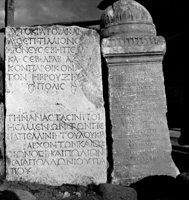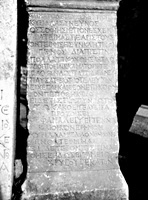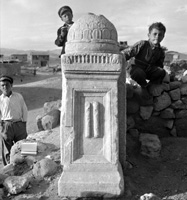 MAMA XI 145 (Pentapolis)
MAMA XI 145 (Pentapolis) 
Funerary bomos for Eutropios
- Type of monument:
- Funerary bomos.
- Location:
- Karasandıklı (Pentapolis): outside the mosque.
- Description:
- Grey-white marble funerary bomos topped by a torus and a pine cone. On left side, in panel, stylus-case in relief; on right, in panel, scroll.
- Dimensions:
- Ht. 1.18; W. 0.38 (upper moulding), 0.33-0.34 (shaft), 0.40 (base); Th. 0.33 (upper moulding), 0.33-0.35 (shaft), 0.42 (base); letters 0.012-0.018.
- Record:
- Partial squeeze (end of lines 1-7 and 16-21); MB notebook copy; photographs (1955/39).
- Publication:
- None.
- Date:
- AD c. 200-250 (bomos-type)
Σῆμα τόδ’ ἔτευξεν Εὐτροπίῳ
Κυρίλλα σύνευνος vac.
ὃς σοφίης μέτρον ἔσχε μ[έ]-
vac. γα τειμάς τε ἀρίστους
5ὃν τείμησε συνκλητικῶν
vac. γένος vac. διὰ πίστιν vac.
πολλά τε μοχθήσαντα ὁ-
δοιπορίαις καμάτοις τε· vac.
ἔλθων δ’ ἰς πατρίδα ἀνε-
10παύσατο βιότοιο τελευτὴν·
εἶχε γὰρ καὶ θεὸν ἐπήκοον
ὅν πεπόθηκει. hed. vac.
εἰ δέ τις τῷ τύνβῳ τού-
τῳ κακοεργέα χεῖρα vac.
15 vac. πρόσοισει, vac.
ὀ̣ρφανὰ λείψει τέκνα
vac. καὶ οἶκον ἔρημον. vac.
Κυρίλλαν τ’ ἄλοχον μόνην̣
vac. ἔνθα̣ τεθῆναι· vac.
20εἰ δ’ ἕτερον τίς τινα
θήσει, δώσει ταμείῳ
vac. χρυσοῦς ἑκατόν.
Kyrilla, his wife, built this monument for Eutropios, who had a great measure of wisdom, and whom a senatorial family (?) honoured with the highest honours on account of his trustworthiness, having laboured greatly during his journeys and his toils. On his return to his homeland, he found rest at the end of his life, for he had a listening God whom he yearned for. And if anybody lays a harmful hand on this tomb, he shall leave his children orphans and his house deserted. Only Kyrilla, his wife, shall be interred here; and if anyone inters anyone else, he shall pay to the treasury one hundred aurei.









This monument belongs to a distinctive group of third-century funerary bomoi with a pine cone-shaped top and relief depiction of domestic objects on the panelled sides. The type is attributed to an Akmoneian workshop by Robert, Hellenica X, 247-8; see further MAMA XI 123 (1955/93: Akmoneia), 124 (1956/42: Akmoneia); MAMA XI 85 (1956/44: Sebaste).
The first twelve lines of the inscription form six rather inaccurate hexameters. Eutropios was concerned to demonstrate his knowledge of classical culture (σοφίης μέτρον μέγα): the point is emphasized by the papyrus roll and stylus-case depicted in relief on the left and right hand panels of the bomos. In lines 4-6, Eutropios is honoured by the ‘race/family of senators’ (συνκλητικῶν γένος). The phrase γένος συνκλητικόν is regularly used (usually in the genitive) to indicate that an individual is ‘of senatorial descent/family’, and the phrase here may well indicate that Eutropios was a dependent, presumably a freedman, of a great senatorial household. His ‘travels and toils’ (lines 7-8) probably allude to a period of labour as a skilled member of a senatorial familia, at Rome or elsewhere, before his eventual manumission (‘honoured with the highest honours’) and a return to his native Phrygian village (line 9, ἔλθων δ’ ἰς πατρίδα). This would fit well with the fact that Eutropios was honoured for his ‘trustworthiness’ (πίστις, line 6), a quality often attributed to loyal slaves and estate-managers (Robert, Hellenica XIII, 36). In an unpublished funerary inscription in the Uşak museum, a certain Cl(audius) Aristion honours his slave (δοῦλον) Maryllos, πίστον γενόμενον καὶ φιλοκύριον.
There is some reason to think that Eutropios and Kyrilla may have been Christians. It is true that the curse formula in lines 13-17 of the inscription (‘he will leave his children orphans and his house deserted’) seems primarily to be used in pagan funerary contexts (Strubbe 1997: 289-92); however, a comparable curse on the violator’s children (ἄ⟨ω⟩[ρ]α τέκνα [ἔ]χωσι) appears in an indisputably Christian inscription from the Pentapolis (Ramsay, Phrygia II 730, no. 658). The notion of a ‘listening God’ (ἐπήκοος, line 11), although common in pagan votive epigraphy (see the commentary to MAMA XI 365 [1956/191: Komitanassos]), seems not to have any direct parallels in Christian epigraphy (Versnel 1981: 26-37). Nonetheless, the verb ποθεῖν has strong Judaeo-Christian connotations, at least in its application to deities; cf. Buckler, Calder and Cox 1928: 33-4, no. 250 (Çakırsaz, upper Tembris valley), a funerary epigram for a Christian Eutychianos, ὃς ἐπό[θ]ησε Θεόν.
The curious phrase in lines 9-10, ἀνεπαύσατο βιότοιο τελευτὴν, may also indicate the author’s Christianity. The Homeric formula βιότοιο τελευτή (H. Il. 7.104; 16.787) is here combined ungrammatically with the verb ἀναπαύεσθαι, a verb which is used overwhelmingly in Christian contexts (e.g. TAM V 2, 1159, Thyateira), referring to the notion of death as a period of sleep in anticipation of the resurrection.